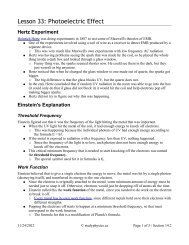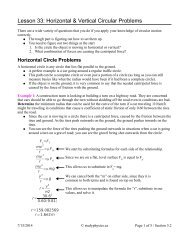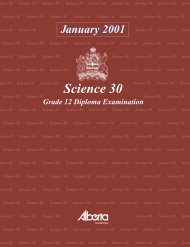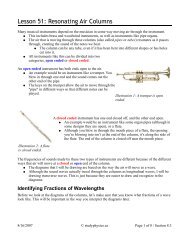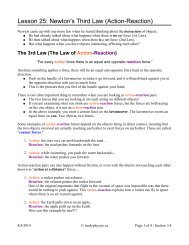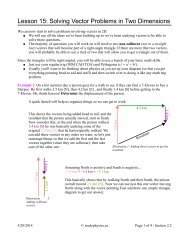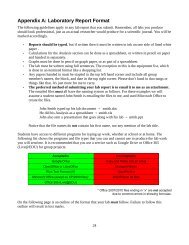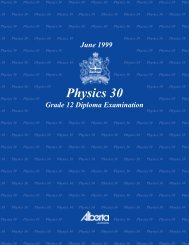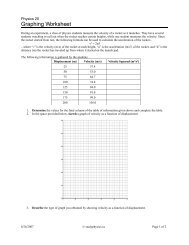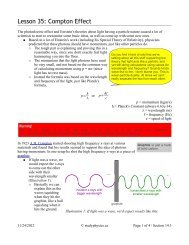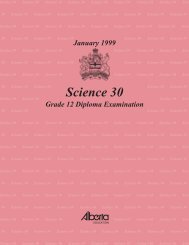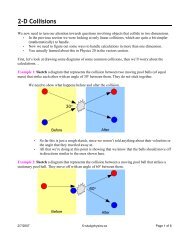January '97 Diploma - Mr. Clintberg's Studyphysics!
January '97 Diploma - Mr. Clintberg's Studyphysics!
January '97 Diploma - Mr. Clintberg's Studyphysics!
Create successful ePaper yourself
Turn your PDF publications into a flip-book with our unique Google optimized e-Paper software.
Copyright 1997, the Crown in Right of Alberta, as represented by the Minister of Education, AlbertaEducation, Student Evaluation Branch, 11160 Jasper Avenue, Edmonton, Alberta T5K 0L2. All rightsreserved. Additional copies may be purchased from the Learning Resources Distributing Centre.Special permission is granted to Alberta educators only to reproduce, for educational purposes and on anon-profit basis, parts of this examination that do not contain excerpted material only after theadministration of this examination.Excerpted material in this examination shall not be reproduced without the written permission of theoriginal publisher (see credits page, where applicable).
<strong>January</strong> 1997Physics 30Grade 12 <strong>Diploma</strong> ExaminationDescriptionTime: 2.5 h. You may take anadditional 0.5 h to complete theexamination.Total possible marks: 70This is a closed-book examinationconsisting of• 37 multiple-choice and 12 numericalresponsequestions, of equal value,worth 70% of the examination• 2 written-response questions, worth atotal 30% of the examinationThis examination contains sets ofrelated questions. A set of questionsmay contain multiple-choiceand/or numerical-response and/orwritten-response questions.A tear-out data sheet is included near theback of this booklet. A Periodic Tableof the Elements is also provided.The blank perforated pages at the backof this booklet may be torn out and usedfor your rough work. No marks will begiven for work done on the tear-outpages.Instructions• Fill in the information required onthe answer sheet and theexamination booklet as directed bythe presiding examiner.• You are expected to provide yourown scientific calculator.• Use only an HB pencil for themachine-scored answer sheet.• If you wish to change an answer,erase all traces of your first answer.• Consider all numbers used in theexamination to be the result of ameasurement or observation.• Do not fold the answer sheet.• The presiding examiner will collectyour answer sheet and examinationbooklet and send them to AlbertaEducation.• Read each question carefully.• Now turn this page and read thedetailed instructions for answeringmachine-scored and writtenresponsequestions.
Multiple Choice• Decide which of the choices bestcompletes the statement or answersthe question.• Locate that question number on theseparate answer sheet provided andfill in the circle that corresponds toyour choice.ExampleThis examination is for the subject ofA. biologyB. physicsC. chemistryD. scienceAnswer SheetExamplesCalculation Question and SolutionIf a 121 N force is applied to a 77.7 kgmass at rest on a frictionless surface,the acceleration of the mass will be_________ m/s 2 .(Round and record your answer to three digits.)a = F ma = 121 N77.7 kg = 1.5572716Numerical Response• Record your answer on the answersheet provided by writing it in theboxes and then filling in thecorresponding circles.• If an answer is a value between 0 and 1(e.g., 0.25), then be sure to record the 0before the decimal place.• Enter the first digit of your answerin the left-hand box and leave anyunused boxes blank.Calculation Question and SolutionA microwave of wavelength 16 cmhas a frequency of b × 10 w Hz.The value of b is _________ .(Round and record your answer to two digits.)f = cf = 3.00 × 108 m/s0.16 m= 1.875 × 10 9ii
Written ResponseCorrect-Order Question and SolutionPlace the following types of EMR in orderof increasing energy:1 blue light2 gamma radiation3 radio waves4 ultraviolet radiation(Record your answer as a a a a .)Answer: 3142• Write your answers in the examinationbooklet as neatly as possible.• For full marks, your answers must bewell organized and address all the mainpoints of the question.• Relevant scientific, technological, and/orsocietal concepts and examples must beidentified and explicit.• Descriptions and/or explanations ofconcepts must be correct and reflectpertinent ideas, calculations, andformulas.• Your answers should be presented in awell-organized manner using completesentences, correct units, and significantdigits where appropriate.Scientific Notation Question andSolutionA hydrogen-like atom whose 3-2 transitionemits light at 164 nm would have an E 1value of –a.b × 10 –cd J. The value of a, b, c,and d, are ______.(Record your answer as a b c d .)Answer: E 1 = –8.7 × 10 –18 Jiii
Numerical Response01. A horizontal force of 207 N acts on a 7.80 kg bowling ball for 0.520 s.The change in the ball’s speed is __________ m/s.(Round and record your answer to three digits.)Use the following information to answer the next two questions.A 0.50 kg steel block starts from rest at point X, which is 4.0 m above theground, and slides along a steel rail. Assume that the steel is frictionless.The path of the block as it slides along the rail is shown below.1. The speed of the block at point Z isA. 4.4 m/sB. 4.9 m/sC. 8.9 m/sD. 14 m/s2. Assuming that the potential energy of the block is zero at ground level, then thetotal mechanical energy of the block at point Y isA. 4.9 JB. 9.8 JC. 15 JD. 20 J1
3. A single stationary railway car is bumped by a five-car train moving at 9.3 km/h.The six cars move off together after the collision. Assuming that the masses of allthe railway cars are the same, then the speed of the new six-car train immediatelyafter impact isA. 7.8 km/hB. 8.5 km/hC. 9.3 km/hD. 11 km/h4. When the electron and the proton in a hydrogen atom are 5.3 × 10 –11 m apart, themagnitude of the electrostatic force on the electron isA. 4.3 × 10 –20 NB. 4.3 × 10 –18 NC. 8.2 × 10 –12 ND. 8.2 × 10 –8 N5. Which graph best represents the magnitude of the electrostatic force, F, as afunction of the distance, r, between two point charges?2
6. The field resulting from a positive point charge and a negative point charge is bestrepresented byUse the following information to answer the next question.Two parallel metal plates are 1.5 cm apart and are maintained at a potentialdifference of 2.5 × 10 2 V.7. The magnitude of the electrical force on an alpha particle when the alpha particle isbetween the plates isA. 5.3 × 10 –15 NB. 2.7 × 10 –15 NC. 5.3 × 10 –17 ND. 2.7 × 10 –17 N3
Use the following information to answer the next three questions.ElectrostaticsTwo identical conducting balls, b 1 and b 2 , each of mass 25.0 g, are hangingon 50.0 cm-long insulating threads. They become equally charged and cometo rest with angles of deviation of 45.0° from the vertical.8. The electrostatic force between the charged balls can best be described asA. an attraction due to dissimilar chargesB. a repulsion due to dissimilar chargesC. an attraction due to similar chargesD. a repulsion due to similar charges9. What is the tension in the thread that is supporting one of the balls?A. 0.173 NB. 0.245 NC. 0.347 ND. 9.81 N10. If the charge on b 1 is tripled and the charge on b 2 is reduced to one-third of itsoriginal amount, the angles of deviation from centre wouldA. increase for b 1 and decrease for b 2B. remain the same for both b 1 and b 2C. increase for both b 1 and b 2D. decrease for both b 1 and b 24
Use the following information to answer the next three questions.The headlight of a car operates with an input power of 75.0 W and draws acurrent of 6.25 A.Numerical Response02. The voltage supplied to the headlight is __________ V.(Round and record your answer to three digits.)Numerical Response03. The number of electrons passing through the headlight every minute, expressed inscientific notation, is a.b × 10 cd electrons. The values of a, b, c, and d are ______.(Record your answer as a b c d .)Numerical Response04. The energy used by the headlight during 1.00 h of operation, expressed inscientific notation, is b × 10 w J. The value of b is __________ .(Round and record your answer to three digits.)5
Use the following information to answer the next three questions.The potential difference between points X and Y is 21.5 V.Numerical Response05. The equivalent resistance for the circuit is __________ Ω.(Round and record your answer to three digits.)Numerical ResponseUse your recorded answer for Numerical Response 5 to solve Numerical Response 6.06. The total current supplied by the 46.0 V power supply to the circuitis __________ A.(Round and record your answer to three digits.)11. The voltage drop across the 20.0 Ω resistor in the circuit isA. 30.6 VB. 24.5 VC. 16.0 VD. 1.53 V6
Use the following information to answer the next three questions.Lightning storms are one of the most spectacular phenomena in nature andplay a key role in maintaining the electrical balance of Earth. One lightningstrike occurred over a potential difference of 200 MV and transferred 12 C ofcharge to the ground in 0.010 s.12. The energy released by the lightning strike in this time interval wasA. 3.2 × 10 –11 JB. 2.4 × 10 3 JC. 2.4 × 10 9 JD. 2.4 × 10 11 JNumerical ResponseUse your recorded answer for Multiple Choice 12 to solve Numerical Response 7.07. The power released in this lightning strike, expressed in scientific notation,is a.b × 10 cd W. The values of a, b, c, and d are __________.(Record your answer as a b c d .)13. People inside a car are protected from the electric fields associated with lightning.Many parts of stereo components are contained in metal boxes. These twoexamples demonstrate that the electric field inside a closed metal container isA. zeroB. opposite to the field outsideC. equal to the field outsideD. half the field outside14. Which of the following unit combinations is not equivalent to an ampere?A. Watt/voltB. Volt/ohmC. Watt/ohmD. Coulomb/second7
15. Energy is used to move a charge of 3.00 C through a circuit with a resistance of1.00 × 10 2 Ω in 1.00 s. If the same amount of energy is used to throw a 1.00 kg ballvertically upward, the maximum height of the ball would beA. 1.09 × 10 –2 mB. 3.27 × 10 –2 mC. 3.06 × 10 1 mD. 9.17 × 10 1 m16. To boil three cups of water each day for one year using an old model of microwaveoven costs $1.10. A new 750 W microwave oven boils one cup of water in 100 s.If the cost of energy is $0.0100/MJ, how much money will a consumer save byusing the new microwave oven to boil three cups of water each day for one year?Assume in each case that the water is at the same starting temperature.A. $0.28B. $0.82C. $1.38D. $2.80Use the following information to answer the next question.Unit CombinationsI. J/CII. N/(A•m)III. TIV. (N•s)/(C•m)17. Which unit combinations could be used correctly for a magnetic field?A. I, III, and IVB. II and III onlyC. II and IV onlyD. II, III, and IV8
18. An electric field of strength 1.5 × 10 4 N/C is perpendicular to a magnetic field ofstrength 3.0 × 10 –3 T. An electron moves perpendicular to both fields and isundeflected as it passes through the fields. The speed of the electron isA. 2.0 × 10 –7 m/sB. 2.0 × 10 –1 m/sC. 5.0 × 10 6 m/sD. 5.0 × 10 7 m/s19. An ideal transformer steps down 25 000 V to 120 V for use in a house. Severalappliances draw a total of 2 000 W from the 120 V side of the transformer. What isthe current in the 25 000 V line?A. 6.00 × 10 –2 AB. 8.00 × 10 –2 AC. 12.5 AD. 16.7 A20. When two parallel conducting wires repel each other, the currents in the wires areA. in opposite directionsB. in the same directionC. oscillating in phaseD. oppositely charged9
Use the following information to answer the next question.Almost all electric guitars use devices called electromagnetic pickups. Aguitar string is composed of metal that becomes magnetized by a permanentmagnet found below the string. A coil of wire surrounds the permanentmagnet.21. When the string is plucked, a small current is produced in the coil of wire becauseA. a potential difference is produced in the stringB. there is a current in the string that can be amplifiedC. there is a charge buildup on the stringD. the string behaves as a magnet moving toward and away from the coil22. French high-speed trains operate using power lines that have an effective voltage of25.0 kV and a frequency of 50.0 Hz. The maximum or peak voltage of the powerlines isA. 12.5 kVB. 17.7 kVC. 35.4 kVD. 50.0 kV10
23. Which of the following diagrams best illustrates the magnetic field near a wire thatcarries an electron current out of the plane of the paper?Numerical Response08. An electromagnetic wave has a frequency of 2.00 × 10 24 Hz. The speed of thewave in a vacuum, expressed in scientific notation, is b × 10 w m/s.The value of b is __________.(Round and record your answer to three digits.)24. In a vacuum, the period of oscillation of a microwave with a wavelength of2.5 cm isA. 8.3 × 10 –11 sB. 8.3 × 10 –9 sC. 1.2 × 10 8 sD. 1.2 × 10 10 s11
Numerical Response09. The minimum potential difference through which an electron must be acceleratedto produce an X-ray of energy 1.62 × 10 4 eV, expressed in scientific notation, isb × 10 w V. The value of b is __________.(Round and record your answer to three digits.)Numerical Response10. A term used in aviation is radar mile, which is the time it takes a radar pulseto travel to a target 1.00 mile away and return (1.00 mile = 1.625 km). Theradar mile, expressed in scientific notation, is b × 10 –w s. The value of bis __________.(Round and record your answer to three digits.)Use the following information to answer the next question.A technological application of quantum theory is the development of“electric eyes,” which can be used in automatic door openers or burglaralarms. A light beam shines across a door opening and causes the productionof a current in a circuit. When the beam is broken, the current stops and amechanism is triggered to open a door or sound an alarm.25. The operation of an electric eye is an application ofA. the Compton effectB. the wave nature of matterC. the photoelectric effectD. Maxwell’s electromagnetic wave theory12
26. To determine the speed of charged particles in a cathode-ray tube, Thomsonbalanced the forces produced byA. an electromagnetic field and a gravitational fieldB. a magnetic field and a gravitational fieldC. an electric field and a gravitational fieldD. an electric field and a magnetic field27. A student performs a photoelectric experiment in which a photoelectric current isobserved for all colours of visible light. The student wants to investigate whateffect varying the intensity and colour of the incident light has on the photoelectriccurrent and kinetic energy of the photoelectrons. If the brightness of the light isdecreased and the colour is changed from yellow to blue, the photoelectricA. current and photoelectron energy both decreaseB. current and photoelectron energy both increaseC. current decreases and the photoelectron energy increasesD. current increases and the photoelectron energy decreases28. When a blue laser beam is incident upon the surface of the metal of a photoelectriccell, there is no photoemission. A second beam of radiation causes photoelectronsto be emitted. The second beam may consist ofA. ultraviolet radiationB. infrared radiationC. red laser radiationD. microwave radiation29. A photon of energy 1.13 eV is emitted by a hydrogen atom when the electron“jumps” fromA. n = 6 to n = 3B. n = 3 to n = 6C. n = 5 to n = 2D. n = 2 to n = 513
Use the following information to answer the next two questions.Energy States of Chromium in a Ruby Crystal LaserA laser can be made using a ruby crystal containing chromium (Cr) atoms.The lasing action can occur only after electrons in the chromium atoms are“pumped” from the ground state to state E 2 using strong flashes of light. Theelectron will then undergo a transition from E 2 to the ground state, E 0 , or tothe intermediate state, E 1 .Photons emitted by the electrons that have undergone transition from E 1 to E 0may strike other electrons at the E 1 state. This causes a new photon to beemitted along with the original photon. These photons are exactly in phaseand moving in the same direction. The cumulative effect of this processcreates the laser beam.30. What is the frequency of light emitted from the laser when the electron in thechromium atom goes from state E 1 to state E 0 ?A. 9.7 × 10 13 HzB. 4.3 × 10 14 HzC. 5.3 × 10 14 HzD. 1.1 × 10 15 HzNumerical Response11. Flashes of light pump electrons in the Cr atoms from the ground state, E 0 , to stateE 2 . The wavelength of these flashes of light, expressed in scientific notation,is b × 10 –w m. The value of b is __________.(Round and record your answer to two digits.)14
Use the following information to answer the next three questions.Photomultiplier TubeWhen the scintillationcrystal is struck by gammaradiation, it emits photonswith a wavelength of4.93 × 10 –7 m. Some ofthese photons strike thephotocathode. As a result,electrons are ejected fromthe bottom surface of thephotocathode. The workfunction of thephotocathode is 2.10 eV.31. The maximum kinetic energy of the electrons ejected from the photocathode isA. 6.7 × 10 –20 JB. 3.4 × 10 –19 JC. 4.0 × 10 –19 JD. 7.4 × 10 –19 J32. The electrons leaving the photocathode are attracted by the 0.20 kV electrode. Themaximum speed they attain isA. 8.6 × 10 5 m/sB. 8.4 × 10 6 m/sC. 7.0 × 10 13 m/sD. 2.1 × 10 15 m/s15
Use the following additional information to answer the next question.Inner Workings of the Photomultiplier TubeAn electron striking the 0.20 kV electrode will use its energy to eject multiplesecondary electrons from the electrode. The secondary electrons acceleratetoward the next electrode, and the process continues along successive increasesin voltage. The energy required to release a single electron is 40.0 eV.33. Assume all of the kinetic energy of an electron striking the 0.20 kV electrode isused to eject secondary electrons. The number of electrons released from the0.20 kV electrode isA. 5B. 10C. 100D. 200Numerical Response12. In the ground state of a hydrogen atom, the radius of the electron orbit is5.3 × 10 –11 m. According to the Bohr model, the radius of the electron orbitcorresponding to the third energy level, expressed in scientific notation, isa.b × 10 –cd m. The values of a, b, c, and d are ______.(Round and record your answer as a b c d .)34. The half-life of radium-226 is 1.6 × 10 3 years. How long will it take for 20.0 mg ofradium-226 to decay to 2.50 mg?A. 1.3 × 10 3 yearsB. 1.6 × 10 3 yearsC. 3.2 × 10 3 yearsD. 4.8 × 10 3 years16
Use the following information to answer the next two questions.Recently H. J. Rose and G.A. Jones of Oxford University predicted that thedecay of radium-223 would emit alpha particles ( 4 He) as well as a few doublealphas ( 8 Be) and even triple alphas ( 12 C).The experiment was run for 600 days. The results of the experiment showedthe detection of 2.2 × 10 10 alpha particles, but the double and triple alphaswere not detected. However, unexpectedly, nineteen carbon-14 nuclei weredetected. This experiment has led scientists to continue to look for otherexamples of radioactive decay in which medium-sized nuclei such ascarbon-14 are produced.35. Which of the following initial products was observed in the greatest abundance?A. Radon-219B. Polonium-215C. Lead-211D. Lead-20936. Which of the following products was not predicted by Rose and Jones?A. Radon-219B. Polonium-215C. Lead-211D. Lead-20937. In a nuclear reaction, the mass of the products was determined to be considerablyless than the mass of the reactants. A correct explanation of this is thatA. the reaction was a beta-decayB. a large amount of energy was released in the reactionC. the mass of the alpha and beta particles was not accounted forD. a large amount of energy was required to cause the reaction to occur17
Written Response — 11 marksUse the following information to answer written-response question 1.A Spring Ram StaplerHeavy-duty stapling guns use powerful springs in combination with a smallmetal rod (called a ram) to produce the impact necessary to move staples ornails into materials such as wood, wallboard, or even concrete.A particular staple gun has a ram with mass 0.200 kg and a spring with a springconstant of 35 000 N/m. When the handle of the gun is squeezed, the spring iscompressed to a maximum value of 3.50 × 10 –2 m. When the ram makescontact with the staple, the spring is still compressed 1.00 × 10 –2 m. Assumethat 3.00% of the ram’s kinetic energy is transferred to the 2.00 g staple whenthe ram hits the staple. The potential energy of a spring is 1 2 kx2 .1. Describe and calculate the energy transformations involved in the operation of thespring ram stapler. Use conservation laws, physics concepts, and related equationsto support your answer. Ignore the mass of the spring and the effects ofgravitational potential energy on the system.Note: A maximum of 8 marks will be awarded for the physics used to answer thisquestion. A maximum of 3 marks will be awarded for the effectivecommunication of your response.18
Written Response — 10 marksUse the following information to answer written-response question 2.A student used the apparatus shown below to measure the radius ofcurvature of the path of electrons as they pass through a magnetic field thatis perpendicular to their path. This experimental design has the voltage asthe manipulated variable, the speed calculated from the voltage, and theradius as the responding variable.AcceleratingPotentialDifference (V) Speed (10 6 m/s) Radius (10 –2 m)20.0 2.65 7.240.0 3.75 9.160.0 4.59 11.080.0 5.30 12.8100.0 5.93 14.1120.0 6.49 16.320Continued
2. a. Plot the graph of radius as a function of speed, and construct abest-fit line.(title)b. Using the slope or other appropriate averaging technique, determinethe strength of the magnetic field.21
c. Derive the equation that would allow the student to calculate thespeed of the electrons from the accelerating potential.You have now completed the examination.If you have time, you may wish to check your answers.22
Fold and tear along perforation.CONSTANTSPHYSICS DATA SHEETSGravity, Electricity, and MagnetismTrigonometry and VectorsAcceleration Due to Gravity orGravitational Field Near Earth .................. a gor g = 9.81 m/s 2 or 9.81 N/kg sin = oppositehypotenuseGravitational Constant............................... G = 6.67 × 10 –11 N•m 2 /kg 2Mass of Earth.............................................Radius of Earth..........................................M e= 5.98 × 10 24 kgR e= 6.37 × 10 6 mCoulomb’s Law Constant.......................... k = 8.99 × 10 9 N•m 2 /C 2Electron Volt .............................................Elementary Charge....................................Index of Refraction of Air ......................... n = 1.00Speed of Light in Vacuum.........................1 eV = 1.60 × 10 –19 Je = 1.60 × 10 –19 Cc = 3.00 × 10 8 m/scos = adjacenthypotenusetanasin A == oppositeadjacentbsin B =csin Cc 2 = a 2 + b 2 – 2abcos CFor any Vector RR = R x2+ Ry2tan= R yR xR x= R cosR y= RsinExponentialAtomic PhysicsEnergy of an Electron in the 1stPrefixes Used With SI UnitsBohr Orbit of Hydrogen ............................ E 1= –2.18 × 10 –18 J or –13.6 eV ExponentialAlpha Particle............... m = 6.65 × 10 –27 kg2+deci ............. d...................10 –1 deka............. da.................10 1Planck’s Constant...................................... h = 6.63 × 10 –34 J•sPrefix Symbol Value Prefix Symbol ValueRadius of 1st Bohr Orbit of Hydrogen...... r 1= 5.29 × 10 –11 mpico.............. p...................10 –12 tera............... T..................10 12Rydberg’s Constant for Hydrogen............. R H= 1.10 × 10 7 /mnano ............ n...................10 –9 giga.............. G..................10 9micro........... µ ..................10 –6mega............ M.................10 6Particlesmilli ............ m..................10 –3 kilo.............. k ..................10 3Rest MassChargecenti ............ c...................10 –2 hecto............ h ..................10 2Electron ........................ m e = 9.11 × 10 –31 kg e –Neutron......................... m n = 1.67 × 10 –27 kg n 0Proton ........................... m p = 1.67 × 10 –27 kg p +
EQUATIONSKinematics Waves and Light Quantum Mechanics and Nuclear Physicsv ave= dd = vtft – 1 2 a t 2T = 2a = v f– v i⎛d =v f+ v i⎞⎜t2⎟ t⎝ ⎠T = 2d = v it + 1 2 a t2 2 2v f = vi + 2adDynamicsF = maF ∆t = m∆vF g= mgF f=F NF s= –kxMomentum and Energyp = mvW = FdW =E = Fd cosF g= Gm 1 m 2r 2g = Gm 1r 2F c= mv2rF c= 4 2 mrT 2E k= 1 2 mv2E p= mghT = 1 fv = fmklg12 = l; 1Atomic Physics4 = l sin 11= n 2 E = mc 2 p = h2n 1Electricity and Magnetism= –d id 0F e= kq 1 q 2r 2+ 1 d 0d isin 2= v 1v 2== xdnl= d sinnm = h ih 01f= 1hf = E kmax+ W 1⎛1 = RH2n – 1 ⎞⎜2fn⎟⎝ i ⎠W = hf 0E n= 1n 2 E 1E kmax= qV stopr n= n 2 r 1E = hf = hc ⎛ 1N = N 0⎜ ⎞ ⎟ n⎝ 2⎠E = kq 1r 2E = F eqE = V dV = ∆EqR = R 1+ R 2+ R 31R = 1 R 1+ 1 R 2+ 1 R 3I eff= 0.707 I maxp = hfc ; E = pcV = IRP = IVI = q tF m= IlB ⊥F m= qvB ⊥V = lvB ⊥N pN s= V pV s= I sI pV eff= 0.707 V maxP = W t= ∆E tE p= 1 2 kx2
PHYSICS 30DIPLOMA EXAMINATIONJANUARY 1997Multiple ChoiceandNumerical ResponseKeyDraftWritten ResponseScoring Guide
MULTIPLE-CHOICE KEY1. A 20. A2. D 21. D3. A 22. C4. D 23. C5. A 24. A6. B 25. C7. A 26. D8. D 27. C9. C 28. A10. B 29. A11. B 30. B12. C 31. A13. A 32. B14. C 33. A15. D 34. D16. A 35. A17. D 36. D18. C 37. B19. BNUMERICAL-RESPONSE KEY1. 13.82. 12.03. 23214. 2.70, 2.75. 30.06. 1.537. 24118. 3.009. 1.6210. 1.0811. 5.6, 5.712. 4810ii
Holistic Scoring GuideReporting Category: Physics COMMUNICATIONWhen marking COMMUNICATION, the marker should consider how effectively the response describesin detail the method, procedure, or strategy used to provide a solution to the problem.ScoreCriteria3 The response:• is complete, well organized and clear• demonstrates in detail a strategy in a logical manner• demonstrates consistency of thought• uses physics vocabulary appropriately and precisely• demonstrates an explicit relationship between the explanation and diagrams (if used)• explicitly states formula(s)• may have a mathematical error present, but it does not hinder the understanding of either thestrategy or the solution2 The response:• is organized, however, errors sometimes affect the clarity• demonstrates a strategy but details are general and/or sometimes lacking• demonstrates consistency of thought most of the time, however, some gaps in logic leave itsomewhat open to interpretation• uses physics vocabulary, however, it may not be precise• demonstrates an implicit relationship between explanation and diagrams (if used)• uses formula(s) that are likely inferred by analyzing the calculations• likely has mathematical errors present that may hinder the understanding of either the strategyor the solution1 The response:• lacks organization and errors affect the clarity• attempts to demonstrate a strategy but provides little or no detail• demonstrates a lack of consistency of thought and it is difficult to interpret• uses physics vocabulary, however, it is often misused• demonstrates a weak relationship between the explanation and diagrams (if used)• may not state formula(s), however, it is possible that they can be deciphered by analyzing thecalculations• has mathematical errors that hinder the understanding of the strategy and/or the solution0 The response:• has very little written and/or contains very little relevant information• is not organized, and is confusing and/or frustrating to the reader• does not demonstrate a strategy to solve the problem• uses little or no physics vocabulary, however, if present, it is misused• demonstrates no relationship between the explanation, if present, and diagrams (if used)• may state formula but it does not contribute towards the solutionNRNo response given.3260971 iii February 10, 1997
Holistic Scoring GuideReporting Category: Physics CONTENTWhen marking CONTENT, the marker should consider how effectively the response uses physics concepts,knowledge, and skills to provide a solution to the problem.ScoreCriteria4 The response:• uses an appropriate method that reflects a thorough understanding of the Conservation ofEnergy and describes the energy transformations involved in the operation of a spring ramstapler• provides a complete description of the method used and shows how to solve the problem• correctly uses formula, and although minor errors in substitution and/or calculation may bepresent they do not hinder the understanding of the physics content• has, if used, diagrams and/or sketches that are appropriate, correct, and complete• has no major omissions or inconsistencies3 The response:• uses an appropriate method that reflects a good understanding of the Conservation of Energyand describes energy transformations involved in the operation of a spring ram stapler• provides a description of the method used and shows how to solve the problem• correctly uses formula, however, errors in substitution and/or calculation may hinder theunderstanding of the physics content• has, if used, diagrams and/or sketches that are appropriate, although some aspect may beincorrect or incomplete• may have several minor inconsistencies or perhaps one major inconsistency, however, there islittle doubt that the understanding of physics content is good2 The response:• uses a method that reflects a basic understanding of the energy transformations involved inthe operation of a spring ram stapler• provides either a description of the method used or shows how to solve the problem• uses formula, however, errors and inconsistencies in substitution and/or calculation hinder theunderstanding of the physics content presented• has, if used, diagrams and/or sketches that may be appropriate, although some aspect isincorrect or incomplete• has inconsistencies or a major omission1 The response:• uses a method that reflects a poor understanding of the energy transformations involved inthe operation of a spring ram stapler• provides a description of the method used, or a solution, that is incomplete• may use formula, however, the application is incorrect or inappropriate• has, if present, diagrams and/or sketches that are inappropriate, incorrect, and/or incomplete• has minor and major inconsistencies and/or omissions0 The response:• uses a method that reflects little or no understanding of the energy transformations involved inthe operation of a spring ram stapler• may have formula and substitution but they do not address energy transformations• has, if present, diagrams and/or sketches that are incorrect, inappropriate, and incomplete• has major omissionsNRNo response is given.3260971 iv February 10, 1997
Written Response — 11 marksUse the following information to answer written-response question 1.A Spring Ram StaplerHeavy-duty stapling guns use powerful springs in combination with a smallmetal rod (called a ram) to produce the impact necessary to move staples ornails into materials such as wood, wallboard, or even concrete.A particular staple gun has a ram with mass 0.200 kg and a spring with a springconstant of 35 000 N/m. When the handle of the gun is squeezed, the spring iscompressed to a maximum value of 3.50 × 10 –2 m. When the ram makescontact with the staple, the spring is still compressed 1.00 × 10 –2 m. Assumethat 3.00% of the ram’s kinetic energy is transferred to the 2.00 g staple whenthe ram hits the staple. The potential energy of a spring is 1 2 kx2 .1. Describe and calculate the energy transformations involved in the operation of thespring ram stapler. Use conservation laws, physics concepts, and related equationsto support your answer. Ignore the mass of the spring and the effects ofgravitational potential energy on the system.Note: A maximum of 8 marks will be awarded for the physics used to answer thisquestion. A maximum of 3 marks will be awarded for the effectivecommunication of your response.3260971 v February 10, 1997
Written Response — 10 marksUse the following information to answer written-response question 2.A student used the apparatus shown below to measure the radius of curvature of thepath of electrons as they pass through a magnetic field that is perpendicular to theirpath. This experimental design has the voltage as the manipulated variable, the speedcalculated from the voltage, and the radius as the responding variable.AcceleratingPotentialDifference (V) Speed (10 6 m/s) Radius (10 –2 m)20.0 2.65 7.240.0 3.75 9.160.0 4.59 11.080.0 5.30 12.8100.0 5.93 14.1120.0 6.49 16.3Continued3260971 vi February 10, 1997
2. a. Plot the graph of radius as a function of speed, and construct a best-fit line.Radius of Curvature as a Function of Speed(title)There are six checks for this part:1. appropriate title consistent with graph (exception special case)2. x-axis is speed and y-axis is radius3. labelling axes appropriately4. scaling axes correctly5. plotting points accurately6. drawing the best fit lineSpecial cases: graphing voltage as a function of speed or voltage vs radius, etc.award a maximum of three checks, 4 ,5, and 63260971 vii February 10, 1997
. Using the slope or other appropriate averaging technique, determine thestrength of the magnetic field.Method 1:slope = riserun= (17.2 - 5.0)10 -2 m/(7.0 - 2.0)10 6 m/s)slope = 2.44 × 10 –8 sF c= F mmv 2R= qvBv = qBRmslope = R v = m qBB ==m(q)(slope)9.11 × 10 -31 kg(1.60 × 10 –19 C)(2.44 × 10 –8 s)B = 2.32 × 10 –4 TB = 2.3 × 10 –4 TThere are six checks for this part:7. explicitly stating slope = rise/run or equivalent8. substitution of points on the line into a valid equation9. calculating slope = 2.4 × 10 –8 s or consistent with graph or substitution10. using F c= F mor equivalent11. using B =m(q)(slope)or consistent with graph12. an answer B = 2.3 × 10 –4 T or consistent with substitution into a validequation3260971 viii February 10, 1997
Method 2:F m= F cqvB = mv2RB = mvqRB 1= (9.11 × 10–31 kg)(2.65 × 10 6 m/s)(1.60 × 10 –19 C)(7.2 × 10 –2 m)B 1= 2.096 × 10 –4 TB 2= 2.346 × 10 –4 TB 3= 2.376 × 10 –4 TB 4= 2.358 × 10 –4 TB 5= 2.395 × 10 –4 TB 6= 2.267 × 10 –4 TB ave= 2.306 × 10 –4 T = 2.3 × 10 –4 TThere are six checks for this part:7. explicitly stating F m= F cor equivalent8. using B = mvqRor equivalent9. correct substitution of values into a valid equation10. calculating the six values of the magnetic field11. explicitly using an average12. an answer B = 2.3 × 10 –4 T or consistent with substitution into a validequationNote: averaging radius and speed results in the loss of checks 9 and 103260971 ix February 10, 1997
c. Derive the equation that would allow the student to calculate the speed of theelectrons from the accelerating potential.E i= E fqV = 1 2 mv2v = 2qV/mThere are four checks for this part:13. stating E = qV or E = 1 2 mv214. using E = 1 2 mv2 and E = qV15. equating qV = 1 2 mv216. an answer v = 2qV/m or v = 2 V/(B r) or equivalentChecksMarks15 or 16 1014 912 or 13 811 79 or 10 68 56 or 7 45 33 or 4 21 or 2 10 03260971 x February 10, 1997



